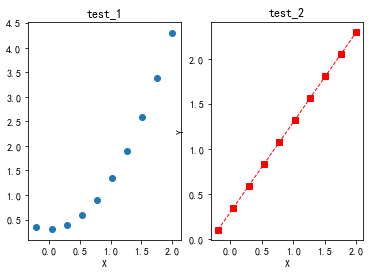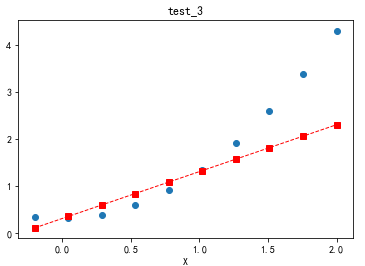1. Python的figure参数主要有:
def figure(num=None, # autoincrement if None, else integer from 1-N figsize=None, # defaults to rc figure.figsize dpi=None, # defaults to rc figure.dpi facecolor=None, # defaults to rc figure.facecolor edgecolor=None, # defaults to rc figure.edgecolor frameon=True, FigureClass=Figure, clear=False, **kwargs ):
可以设置图片大小、分辨率、颜色等。
2. subplot子图绘制,子图的绘图参数可以分别设置
plt.figure(1) x1 = np.linspace(-0.2, 2, 10) y1 = x1**2 + 0.3 plt.subplot(121) plt.scatter(x1, y1) plt.xlabel('X') plt.ylabel('Y') plt.title('test_1') x2 = np.linspace(-0.2, 2, 10) y2 = x2 + 0.3 plt.subplot(122) plt.plot(x2, y2, color="red", linewidth=1.0, marker = 's', linestyle="--") ## plt.plot(x, y, color="#ef5492", linewidth=2.0, marker = 's', linestyle="--") # plt.plot(x2, y2, 'rs--') plt.xlabel('X') plt.ylabel('Y') plt.title('test_2') plt.show()

3. 在同一张图片上显示多种图形,简单说把 plt.show()放在最后即可
import matplotlib.pyplot as plt import numpy as np plt.figure(2) x1 = np.linspace(-0.2, 2, 10) y1 = x1**2 + 0.3 plt.scatter(x1, y1) x2 = np.linspace(-0.2, 2, 10) y2 = x2 + 0.3 plt.plot(x2, y2, color="red", linewidth=1.0, marker = 's', linestyle="--") ## plt.plot(x, y, color="#ef5492", linewidth=2.0, marker = 's', linestyle="--") # plt.plot(x2, y2, 'rs--') plt.xlabel('X') plt.ylabel('Y') plt.title('test_3') plt.show()

更多参数设置可见:
https://www.cnblogs.com/qi-yuan-008/p/12588351.html
https://www.cnblogs.com/qi-yuan-008/p/12588121.html
##
参考: